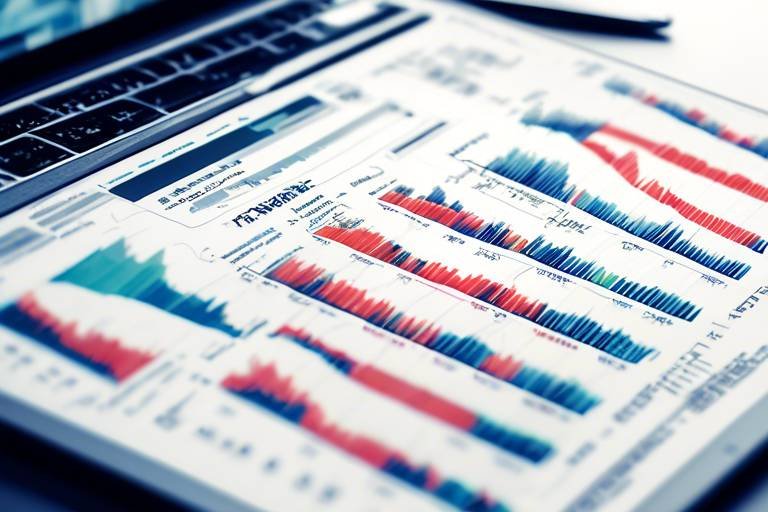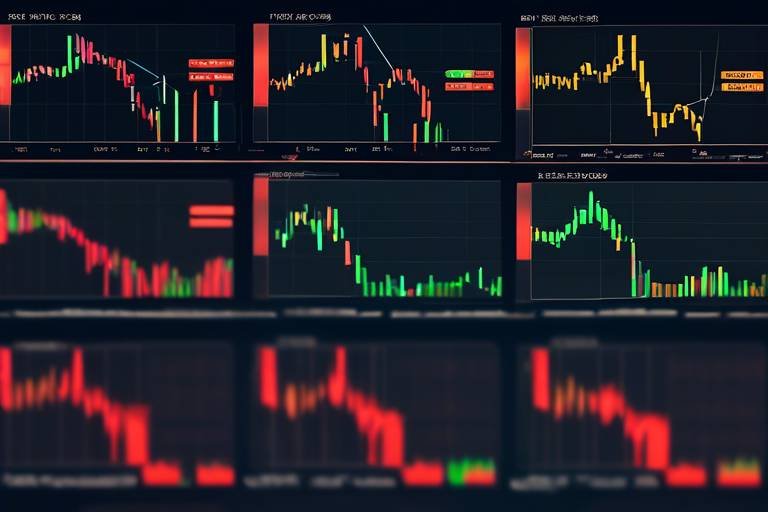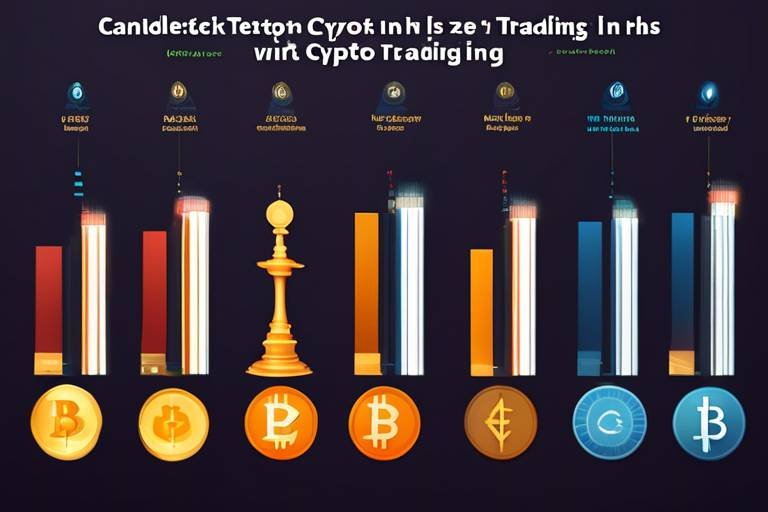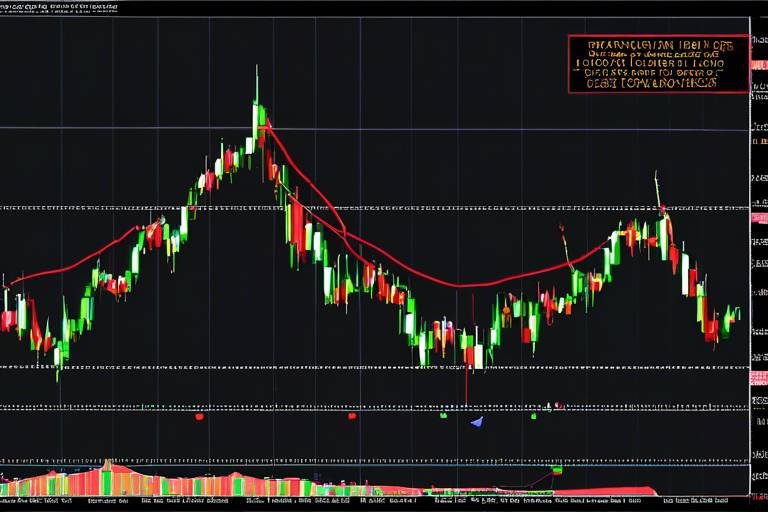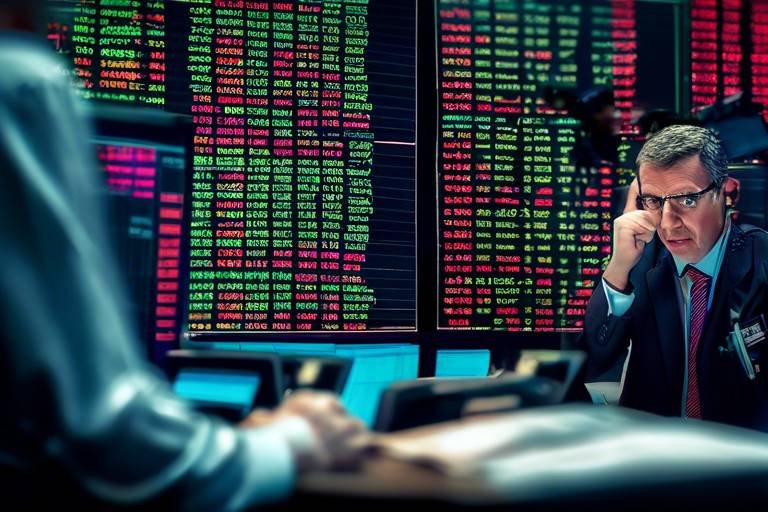Understanding the Risks of Technical Analysis in Volatile Markets
In the world of trading, technical analysis is often hailed as a powerful tool for predicting market movements. However, when it comes to volatile markets, the risks associated with relying solely on technical indicators can be significant. Volatile markets are like a roller coaster ride, with prices swinging wildly in both directions, which can make even the most seasoned traders feel queasy. Understanding these risks is not just important; it's essential for anyone looking to navigate the tumultuous waters of trading.
Volatile markets can be characterized by rapid price fluctuations, making them unpredictable and challenging for traders. In such environments, the effectiveness of technical analysis can diminish, leading to potential pitfalls. Imagine trying to read a map during a storm; the wind and rain can easily obscure your view, just as volatility can obscure market signals. Therefore, having a firm grasp of market behavior and the limitations of various indicators is crucial when making trading decisions.
As we delve deeper into the world of technical analysis, it's vital to recognize that not all indicators are created equal. Some may work well in stable markets but can mislead traders in volatile conditions. For instance, indicators like moving averages and the Relative Strength Index (RSI) can provide insights, but they also come with their own set of risks. Understanding how these indicators perform in different market conditions can help traders make more informed decisions.
In this article, we'll explore the inherent risks of using technical analysis in volatile markets, emphasizing the importance of a comprehensive understanding of market behavior, indicators, and potential pitfalls. By doing so, traders can better navigate the complexities of the market and improve their chances of success.
Volatile markets are a double-edged sword. On one hand, they present opportunities for traders to capitalize on rapid price movements; on the other hand, they come with heightened risks. The very nature of volatility means that prices can change drastically within minutes or even seconds. This unpredictability can lead to emotional decision-making, which is often detrimental to a trader's strategy.
Understanding the nature of volatile markets requires recognizing the factors that contribute to rapid price changes. Economic news releases, geopolitical events, and sudden shifts in market sentiment can all trigger volatility. Traders must remain vigilant and adaptable, as the market can change in the blink of an eye.
When it comes to technical analysis, several indicators are commonly used to analyze market trends. These indicators can provide valuable insights, but they can also mislead traders, especially in volatile environments. Let's take a closer look at some of the most popular technical indicators and their potential pitfalls.
Moving averages are designed to smooth out price data over a specific period, helping traders identify trends. However, in volatile conditions, they often lag behind actual price movements. This lag can lead to delayed signals, which may result in missed opportunities or, worse, losses for traders who rely on them exclusively. Think of moving averages as a ship's anchor; they can provide stability, but in choppy waters, they may not react quickly enough to changing tides.
The Simple Moving Average (SMA) calculates the average price over a specific time frame. While it can be useful in stable markets, the SMA can produce false signals in volatile conditions. Traders may find themselves entering or exiting trades based on misleading information, prompting a reevaluation of its reliability.
On the other hand, the Exponential Moving Average (EMA) gives more weight to recent prices, making it more responsive than the SMA. While this can be advantageous, it can also lead to misleading signals in volatile markets. Traders must be cautious and consider the context of the market before acting on EMA signals.
The Relative Strength Index (RSI) measures the speed and change of price movements, providing insights into whether an asset is overbought or oversold. However, in volatile markets, RSI readings can become distorted, leading traders to misinterpret market conditions. This misinterpretation can result in poor trading decisions, underscoring the need for a comprehensive understanding of market dynamics.
Beyond technical indicators, psychological factors play a significant role in trading decisions, particularly in volatile markets. Emotions such as fear and greed can cloud judgment, leading to impulsive actions that technical analysis may not predict. Understanding these psychological factors is crucial for mitigating risks associated with technical analysis.
Fear and greed are powerful emotions that can drive traders to make irrational decisions. In volatile markets, fear of missing out (FOMO) or fear of losing can lead to hasty trades that ultimately result in losses. Recognizing these emotions and implementing strategies to manage them can help traders maintain a level head amidst the chaos.
Cognitive biases, such as confirmation bias and loss aversion, can hinder a trader's ability to analyze data objectively. For instance, a trader might only seek information that confirms their existing beliefs, ignoring contradictory signals. Understanding these biases is essential for improving decision-making processes in volatile environments.
Effective risk management strategies are vital for navigating volatile markets. While technical analysis can provide valuable insights, it must be complemented by robust risk management techniques. Traders should consider the following approaches to protect their investments:
Stop-loss orders are essential tools for limiting potential losses. In volatile markets, setting appropriate stop-loss levels can help traders maintain control over their trades and manage risk effectively. By establishing clear exit points, traders can avoid emotional decision-making and stick to their trading plans.
Diversification can reduce overall portfolio risk. By spreading investments across various assets, traders can mitigate the impact of volatility on technical analysis outcomes. This approach can provide a safety net during turbulent times, allowing traders to weather the storm more effectively.
In conclusion, while technical analysis can provide valuable insights, it is crucial for traders to balance their analysis with a solid understanding of market risks, especially in volatile conditions. By recognizing the inherent risks associated with technical indicators, understanding psychological factors, and implementing effective risk management strategies, traders can enhance their chances of success in the ever-changing landscape of volatile markets.
- What is technical analysis? Technical analysis is a method used to evaluate securities by analyzing statistics generated by market activity, such as past prices and volume.
- Why is technical analysis risky in volatile markets? Volatile markets can lead to rapid price changes that may distort the signals provided by technical indicators, increasing the likelihood of poor trading decisions.
- How can I manage risk while using technical analysis? Implementing strategies such as setting stop-loss orders and diversifying your portfolio can help mitigate risks associated with technical analysis in volatile markets.

The Nature of Volatile Markets
Volatile markets are like roller coasters—full of ups and downs that can leave even the most seasoned traders feeling dizzy. These markets are characterized by rapid price fluctuations, which can occur due to a variety of factors, including economic news, geopolitical events, and changes in market sentiment. Understanding the nature of these fluctuations is crucial for anyone looking to make informed trading decisions. After all, if you don't know what you're dealing with, how can you expect to navigate the chaos?
In a volatile market, prices can swing dramatically within short periods, making it challenging to predict future movements. For instance, a stock that might typically trade within a narrow range could suddenly experience a price spike or drop of several percentage points in just a few hours. This unpredictability can make technical analysis both a valuable tool and a potential trap for traders. It's essential to recognize that traditional indicators may not always perform as expected in these conditions.
To illustrate the impact of volatility, consider the following table, which shows the average daily price changes of a stock in stable versus volatile market conditions:
| Market Condition | Average Daily Price Change (%) |
|---|---|
| Stable Market | 1-2% |
| Volatile Market | 5-10% |
This table highlights just how significant the differences can be. In a stable market, traders can rely on technical analysis with a higher degree of confidence, as price movements are more predictable. However, in volatile markets, the rapid price changes can lead to false signals and misinterpretations of trends, making technical indicators less reliable.
Moreover, the emotional aspect of trading in volatile markets cannot be overlooked. Traders often find themselves reacting to sudden price movements, which can lead to impulsive decisions driven by fear or greed. This emotional rollercoaster can cause traders to abandon their strategies, further complicating the already unpredictable environment. Thus, understanding the nature of volatile markets goes beyond just recognizing price movements; it involves managing one's emotions and expectations as well.
In summary, volatile markets are defined by their unpredictable price movements and can pose significant challenges for traders. To navigate these turbulent waters, it's vital to have a solid grasp of market behavior, utilize appropriate technical analysis tools cautiously, and remain aware of the psychological factors at play. Only then can traders hope to make informed decisions amidst the chaos.

Key Technical Indicators
When navigating the tumultuous waters of volatile markets, understanding technical indicators is crucial for traders looking to make informed decisions. These indicators act like a compass, guiding traders through the chaos of price fluctuations. However, just like a compass can lead you astray if not used correctly, technical indicators can sometimes mislead traders, especially when the market is swinging wildly. Let's dive deeper into some of the most popular technical indicators and explore how they function, as well as the potential pitfalls they present in volatile environments.
One of the most widely used indicators is the Moving Average. This tool helps to smooth out price data over a specific period, allowing traders to identify trends more clearly. However, in volatile markets, moving averages can lag behind actual price movements. This lag can result in delayed signals, which may lead traders to make decisions based on outdated information. It's like trying to catch a wave with a surfboard that’s stuck in the sand—by the time you’re ready, the wave has already passed!
The Simple Moving Average (SMA) is perhaps the most basic form of moving average. It calculates the average price of an asset over a predetermined period, such as 10 or 50 days. While it’s an excellent tool for spotting general trends, in a highly volatile market, the SMA can produce a series of false signals. For instance, if a trader relies solely on the SMA during a sudden market downturn, they might miss the opportunity to sell before prices plummet. This highlights the importance of not putting all your eggs in one basket—consider using other indicators alongside the SMA for a more comprehensive view of market conditions.
In contrast, the Exponential Moving Average (EMA) gives greater weight to recent prices, making it more responsive to new information. This can be advantageous in fast-moving markets, as it allows traders to react more quickly to price changes. However, the EMA is not foolproof. In volatile conditions, it can still create misleading signals that may lead traders to enter or exit positions prematurely. Think of it as a sports car—while it can accelerate quickly, it also requires skilled handling to navigate sharp turns safely.
Another vital indicator is the Relative Strength Index (RSI), which measures the speed and change of price movements. The RSI is often used to identify overbought or oversold conditions in the market. However, during periods of high volatility, the readings can become distorted, leading to misinterpretations. For instance, a trader might see an RSI reading that indicates an asset is oversold and rush to buy, only to find that the price continues to drop further. This situation underscores the importance of combining the RSI with other indicators to paint a fuller picture of market sentiment.
| Indicator | Function | Potential Pitfall |
|---|---|---|
| Simple Moving Average (SMA) | Smooths price data to identify trends | Can lag behind actual price movements |
| Exponential Moving Average (EMA) | Gives more weight to recent prices | May generate misleading signals in volatility |
| Relative Strength Index (RSI) | Measures speed and change of price movements | Can lead to misinterpretations in volatile conditions |
In conclusion, while technical indicators can provide valuable insights into market trends, traders must exercise caution when relying on them in volatile markets. It's essential to use a combination of indicators to validate signals and avoid making impulsive decisions based on misleading data. Just as a seasoned sailor reads the wind and waves before setting sail, traders should analyze multiple indicators and market behaviors to navigate the unpredictable seas of trading successfully.
- What is the best technical indicator for volatile markets?
There is no single best indicator; however, combining multiple indicators like EMA and RSI can provide a more comprehensive view. - How can I manage risks when using technical analysis?
Implementing stop-loss orders and diversifying your portfolio can help manage risks associated with technical analysis. - Can emotional factors affect trading decisions?
Absolutely! Emotions like fear and greed can cloud judgment and lead to impulsive trading decisions.

Moving Averages
Moving averages are one of the most widely used technical indicators in the trading world. They serve as a tool to smooth out price data over a specified period, helping traders identify the direction of the trend more clearly. However, in the context of volatile markets, the effectiveness of moving averages can be questionable. Think of moving averages like a ship's rudder; they help steer you in the right direction, but if the waters are choppy, you might find yourself off course.
The two primary types of moving averages are the Simple Moving Average (SMA) and the Exponential Moving Average (EMA). Each has its unique characteristics and applications. While the SMA provides a straightforward average of prices over a set period, the EMA gives more weight to recent prices, making it more responsive to new information. This responsiveness is crucial in fast-moving markets, but it can also lead to a double-edged sword effect. When the market is buzzing with activity, both indicators can produce signals that may not accurately reflect the current market sentiment.
For instance, during periods of high volatility, the SMA can lag behind the actual price movements, leading to delayed signals. This lag can cause traders to enter or exit positions too late, resulting in missed opportunities or unexpected losses. On the other hand, while the EMA is designed to react more quickly to price changes, it can sometimes generate false signals in erratic market conditions. Traders relying solely on these indicators without considering the broader market context could find themselves in precarious situations.
To illustrate the differences, let's take a look at a simple comparison between the two moving averages in a volatile market scenario:
| Indicator | Response to Price Changes | Risk of False Signals |
|---|---|---|
| Simple Moving Average (SMA) | Slower, may lag behind | Higher in volatile markets |
| Exponential Moving Average (EMA) | Faster, more responsive | Moderate, but still present |
In conclusion, while moving averages can be useful tools for traders, it's essential to approach them with caution in volatile markets. Relying on them exclusively can lead to significant pitfalls. Instead, consider using them in conjunction with other indicators and market analysis techniques to paint a more comprehensive picture of market behavior. This multi-faceted approach can help mitigate risks and improve trading outcomes in an unpredictable trading environment.
- What are moving averages? Moving averages are indicators that smooth out price data to help traders identify trends over a specific period.
- How do moving averages work in volatile markets? In volatile markets, moving averages may lag behind actual price movements, leading to delayed signals and potential losses.
- Which is better, SMA or EMA? It depends on your trading strategy; SMA is simpler but slower, while EMA is more responsive but can produce false signals in volatile conditions.
- Can moving averages be used alone for trading decisions? No, it's advisable to use moving averages in conjunction with other indicators and analysis methods for better decision-making.

Simple Moving Average (SMA)
The is one of the most fundamental tools in the arsenal of a trader. It calculates the average price of a security over a specific number of periods, providing a clear view of the underlying trend. For instance, if you were to look at a 10-day SMA, it would take the closing prices of the last 10 days, sum them up, and then divide by 10. This straightforward calculation makes it easy for traders to identify trends at a glance.
However, the simplicity of the SMA can also be its downfall, especially in volatile markets. During periods of high volatility, prices can swing dramatically, and the SMA tends to lag behind these rapid changes. This lag can result in what traders call "false signals." For example, if a stock price suddenly spikes, the SMA may not reflect this change immediately, leading traders to make decisions based on outdated information. This can be particularly problematic when the market is in a state of flux, as traders may find themselves entering or exiting positions at inopportune times.
To illustrate, let’s consider a scenario where a trader uses a 20-day SMA. If the market experiences a sudden downturn, the SMA will only begin to reflect this trend after several days, potentially causing the trader to miss the opportunity to sell before significant losses occur. This lag can be likened to trying to catch a train that has already left the station. By the time the SMA indicates a downward trend, the trader may have already faced substantial losses.
Furthermore, it’s essential to understand that the SMA can produce false breakouts. In volatile markets, prices may temporarily cross above or below the SMA, leading traders to believe that a new trend is forming. However, these movements can be short-lived, resulting in losses when the price reverts back. Thus, while the SMA can be a useful tool for identifying trends, traders should be cautious and consider using it in conjunction with other indicators for a more comprehensive analysis.
In summary, while the Simple Moving Average is a valuable indicator, its limitations in volatile markets cannot be overlooked. Traders should be aware of its tendency to lag and the potential for false signals. By combining the SMA with other technical indicators and maintaining a strong risk management strategy, traders can better navigate the choppy waters of volatile markets.
- What is the primary purpose of the Simple Moving Average? The SMA is used to identify trends by averaging past prices over a specified period.
- How does volatility affect the reliability of the SMA? In volatile markets, the SMA may lag behind actual price movements, leading to misleading signals.
- Can the SMA be used in conjunction with other indicators? Yes, combining the SMA with other technical indicators can provide a more accurate market analysis.
- What is a common period used for the SMA? Common periods include 10, 20, 50, and 200 days, depending on the trader's strategy.

Exponential Moving Average (EMA)
The is a popular technical indicator that traders often use to gauge the direction of price trends. Unlike the Simple Moving Average (SMA), which treats all price points equally, the EMA gives greater weight to more recent prices. This characteristic makes the EMA more responsive to new information, allowing traders to react quicker to market changes. However, this responsiveness can be a double-edged sword, especially in volatile markets.
In volatile conditions, the EMA can sometimes send misleading signals. For instance, when prices swing dramatically, the EMA may react too quickly, resulting in false breakouts or reversals. Traders relying solely on the EMA might find themselves entering or exiting trades based on these errant signals, leading to potential losses. It's crucial to remember that while the EMA can highlight trends effectively, it does not predict sudden market shifts.
To illustrate how the EMA works, consider the following example. Let's say a trader is analyzing a stock that has experienced a price surge followed by a sharp decline. The EMA will likely track the recent price movements closely, reflecting the rapid changes. However, if the market stabilizes, the EMA may lag behind, failing to capture the new trend accurately. This can create a scenario where traders feel confident based on the EMA's indication, only to be caught off-guard by an unexpected market shift.
Additionally, traders often use the EMA in conjunction with other indicators to enhance their decision-making process. For example, combining the EMA with the Relative Strength Index (RSI) can provide a more comprehensive view of market conditions. The EMA can signal the trend, while the RSI can help identify overbought or oversold conditions. This dual approach can mitigate some risks associated with relying solely on the EMA.
In summary, while the Exponential Moving Average is a powerful tool for identifying trends in the market, traders must exercise caution. Understanding its limitations, especially in volatile markets, is essential for making informed trading decisions. Always consider using the EMA alongside other technical indicators and risk management strategies to navigate the complexities of trading effectively.
- What is the main difference between EMA and SMA? The EMA gives more weight to recent prices, making it more responsive to new information compared to the SMA, which treats all prices equally.
- Can the EMA be used for all types of markets? Yes, the EMA can be applied in various markets, but its effectiveness may vary depending on market volatility.
- How can I combine EMA with other indicators? Traders often use the EMA alongside indicators like the RSI or MACD to confirm trends and reduce the risk of false signals.
- Is the EMA suitable for long-term trading? While the EMA is primarily used for short to medium-term trading, it can also be adapted for longer-term strategies by adjusting the time frame used for calculations.

Relative Strength Index (RSI)
The is a powerful momentum oscillator that measures the speed and change of price movements. Developed by J. Welles Wilder Jr., this indicator is designed to provide traders with insights into whether an asset is overbought or oversold. Typically, an RSI reading above 70 suggests that an asset may be overbought, while a reading below 30 indicates it may be oversold. However, in the chaotic environment of volatile markets, these traditional thresholds can often lead to misinterpretations and false signals.
In volatile markets, the RSI can become distorted due to rapid price fluctuations. For instance, if a stock experiences sharp price movements, the RSI may spike or drop suddenly, creating misleading signals. Traders may interpret these extreme readings as definitive buy or sell signals, only to find that the market quickly reverses direction. This phenomenon highlights the importance of using the RSI in conjunction with other indicators and market analysis techniques.
Moreover, the RSI's effectiveness can be further compromised during periods of extreme volatility, as it tends to react to price changes rather than predict future movements. This lag can result in traders making decisions based on outdated information, leading to potential losses. To better illustrate this, consider the following table that summarizes the RSI's behavior in different market conditions:
| Market Condition | RSI Reading | Interpretation |
|---|---|---|
| Stable Market | 70+ | Possible overbought condition |
| Stable Market | 30- | Possible oversold condition |
| Volatile Market | 70+ | Potential false signal; watch for reversal |
| Volatile Market | 30- | Potential false signal; watch for reversal |
To mitigate the risks associated with relying solely on the RSI in volatile markets, traders should consider using additional technical indicators to confirm signals. For example, combining the RSI with moving averages or trend lines can provide a more comprehensive view of market dynamics. This multi-faceted approach not only enhances the reliability of trading signals but also helps traders navigate the unpredictable nature of volatile markets.
- What is the best RSI setting for trading? The standard setting is 14 periods, but traders may adjust this based on their trading strategy and the asset's volatility.
- Can RSI be used for long-term trading? Yes, while RSI is often used for short-term trading, it can also be beneficial for long-term strategies when combined with other indicators.
- How often should I check the RSI? Regular monitoring is essential, especially in volatile markets. Many traders check RSI daily or even hourly, depending on their trading style.

Psychological Factors in Trading
The world of trading is not just about numbers and charts; it's also a psychological battlefield. When traders step into the volatile markets, they often find themselves wrestling with their own emotions. Fear and greed are two of the most potent emotions that can significantly cloud judgment and lead to poor decision-making. For instance, when prices begin to fluctuate wildly, fear can trigger a sense of panic, causing traders to sell off assets at a loss. On the flip side, greed can push traders to hold onto winning positions for too long, hoping for even greater returns, only to watch their profits evaporate in a sudden downturn.
Understanding these psychological factors is crucial for anyone looking to navigate the choppy waters of trading. In volatile markets, where price swings can be dramatic, the impact of emotions can be magnified. Traders might find themselves falling prey to cognitive biases, which can distort their perception of reality. For example, confirmation bias might lead a trader to only seek information that supports their existing beliefs, ignoring any data that contradicts their viewpoint. This can be particularly dangerous in a fast-moving market where quick decisions are often necessary.
Moreover, loss aversion—the tendency to prefer avoiding losses rather than acquiring equivalent gains—can lead traders to hold onto losing positions longer than they should. Instead of cutting their losses, they may hope for a rebound, which often never comes. This emotional rollercoaster can make technical analysis seem less reliable, as traders may act impulsively rather than following their well-researched strategies.
To combat these psychological pitfalls, traders can adopt several strategies:
- Self-awareness: Recognizing one’s emotional triggers can help traders make more rational decisions.
- Predefined rules: Establishing a set of trading rules can mitigate impulsive actions driven by fear or greed.
- Mindfulness practices: Techniques such as meditation can enhance focus and reduce stress, allowing traders to think more clearly.
By understanding the psychological factors at play, traders can better prepare themselves for the challenges of volatile markets. It’s essential to develop a mindset that balances technical analysis with an awareness of emotional influences. After all, trading isn’t just about the charts; it’s about mastering oneself in the face of uncertainty.
Q: How do emotions affect trading decisions?
A: Emotions like fear and greed can lead to impulsive decisions, causing traders to act against their strategies.
Q: What is loss aversion in trading?
A: Loss aversion is the tendency to prefer avoiding losses over acquiring equivalent gains, which can lead to holding onto losing trades for too long.
Q: How can traders manage their psychological biases?
A: Traders can manage biases by practicing self-awareness, establishing predefined trading rules, and using mindfulness techniques.

Fear and Greed
The world of trading is a thrilling roller coaster, driven by the powerful emotions of fear and greed. These two emotions are like the twin engines of a train, propelling traders forward but also threatening to derail them at any moment. In volatile markets, where prices can swing wildly in a matter of minutes, the influence of fear and greed becomes even more pronounced. Traders often find themselves caught in a whirlwind of emotions, which can cloud their judgment and lead to impulsive decisions.
When prices are rising rapidly, greed can take over, making traders feel invincible. They might think, "If I just hold on a little longer, I can make a killing!" This mindset can lead to overexposure in the market, ignoring the warning signs that a downturn may be imminent. On the flip side, when the market takes a nosedive, fear can grip even the most seasoned investors. The instinct to cut losses can trigger a panic sell-off, often at the worst possible moment. This emotional roller coaster can result in significant losses that technical analysis might not predict.
To navigate the treacherous waters of fear and greed, traders need to develop a strategy that includes emotional discipline. Here are a few techniques that can help:
- Set Clear Goals: Having specific, measurable goals can help keep emotions in check. When traders know what they’re aiming for, they’re less likely to be swayed by short-term market fluctuations.
- Stick to a Trading Plan: A well-defined trading plan can serve as a roadmap, guiding decisions and helping to mitigate emotional reactions. This includes setting entry and exit points based on analysis rather than impulse.
- Practice Mindfulness: Techniques such as meditation or deep-breathing exercises can help traders maintain a level head, allowing them to make more rational decisions even in the heat of the moment.
Ultimately, understanding the psychological impacts of fear and greed is crucial for anyone involved in trading. By recognizing these emotions and implementing strategies to manage them, traders can improve their decision-making processes and better navigate the volatile markets. It’s about finding that delicate balance between being aggressive enough to seize opportunities and cautious enough to protect against potential losses.
Q1: How do fear and greed affect trading decisions?
A1: Fear and greed can lead to impulsive trading decisions. Greed may cause traders to hold onto positions for too long, while fear can trigger panic selling.
Q2: What strategies can help manage fear and greed?
A2: Setting clear goals, sticking to a trading plan, and practicing mindfulness can help traders manage their emotions effectively.
Q3: Can technical analysis help mitigate the effects of fear and greed?
A3: While technical analysis provides valuable insights, it's essential to combine it with emotional discipline to make informed trading decisions.

Cognitive Biases
Cognitive biases are mental shortcuts that can lead to irrational decision-making, particularly in the high-stakes world of trading. When traders are faced with the unpredictable nature of volatile markets, these biases can significantly distort their judgment. For instance, one common bias is confirmation bias, where traders tend to favor information that confirms their pre-existing beliefs while ignoring contradictory evidence. Imagine a trader who believes a stock is going to rise; they might only pay attention to positive news articles while dismissing any negative reports. This selective perception can lead to poor investment decisions.
Another prevalent bias is loss aversion, which describes the tendency to prefer avoiding losses rather than acquiring equivalent gains. In volatile markets, where prices fluctuate wildly, this bias can cause traders to hold onto losing positions longer than they should, hoping for a rebound. They might think, "If I just wait a little longer, I can break even," but in reality, this often leads to even greater losses. The emotional toll of seeing a portfolio decrease in value can cloud judgment, making it crucial for traders to recognize and combat these biases.
Additionally, the overconfidence bias can be a double-edged sword. Traders may overestimate their knowledge or ability to predict market movements, leading to risky decisions. For example, a trader might feel invincible after a few successful trades, prompting them to increase their investment size without proper analysis. This can be particularly dangerous in volatile markets, where unexpected shifts can occur at any moment.
To combat these cognitive biases, traders should consider implementing structured decision-making processes. Here are some strategies to mitigate the effects of cognitive biases:
- Maintain a Trading Journal: Documenting trades and the rationale behind them can help traders reflect on their decisions and identify patterns of bias.
- Set Clear Rules: Establishing specific criteria for entering and exiting trades can reduce emotional decision-making.
- Seek External Opinions: Getting a second opinion from a trusted colleague or mentor can provide a fresh perspective and counteract personal biases.
By understanding and addressing these cognitive biases, traders can enhance their ability to analyze market data objectively. This awareness not only helps in making informed decisions but also fosters a disciplined approach to trading, which is particularly vital in the unpredictable landscape of volatile markets.
- What are cognitive biases? Cognitive biases are systematic patterns of deviation from norm or rationality in judgment, often leading to illogical conclusions.
- How do cognitive biases affect trading? They can distort a trader's perception of market conditions, leading to poor decision-making and increased risk.
- What can traders do to mitigate cognitive biases? Traders can maintain a trading journal, set clear rules for trading, and seek external opinions to gain a more objective perspective.
- Why is understanding cognitive biases important in volatile markets? In volatile markets, the emotional impact of rapid price changes can exacerbate cognitive biases, making it crucial for traders to recognize and manage them effectively.

Risk Management Strategies
In the unpredictable world of trading, especially within volatile markets, having effective is not just a good idea—it's essential. Just as a skilled sailor navigates through stormy seas with a sturdy ship and a well-thought-out plan, traders need to arm themselves with strategies that can help them weather the financial storms. The goal here is to protect your investments while still leveraging the insights provided by technical analysis. Let’s dive into some of the most effective risk management techniques that can help you stay afloat.
One of the most fundamental tools in a trader's arsenal is the stop-loss order. Think of it as a safety net that catches you before you fall too far. By setting a stop-loss order, you can automatically close a position when it reaches a certain price point, thus limiting potential losses. However, in volatile markets, it’s crucial to set these levels wisely. Too tight, and you may get stopped out during a normal price fluctuation; too loose, and you risk substantial losses. Understanding market behavior can help you determine the most appropriate stop-loss levels.
Another effective strategy is diversification. Just like a balanced diet is essential for good health, a well-diversified portfolio can help mitigate risks associated with volatility. By spreading your investments across various asset classes—such as stocks, bonds, and commodities—you reduce the impact of any single asset's poor performance on your overall portfolio. For instance, if one sector experiences a downturn, gains in another can help cushion the blow. Here’s a simple illustration of how diversification can work:
| Asset Class | Percentage of Portfolio | Expected Return |
|---|---|---|
| Stocks | 50% | 8% |
| Bonds | 30% | 4% |
| Commodities | 20% | 6% |
As you can see, diversifying your portfolio can lead to a more balanced risk-reward profile. Additionally, consider employing position sizing techniques. This involves determining how much capital to allocate to each trade based on your overall risk tolerance. A common rule is to risk no more than 1-2% of your total trading capital on a single trade. This way, even if you face a series of losses, your overall portfolio remains intact, giving you the chance to recover.
Lastly, constant review and adjustment of your strategies are vital. Markets are dynamic, and what works today may not work tomorrow. Regularly analyzing your trades and learning from both your successes and failures can provide insights that help refine your approach. Consider keeping a trading journal to document your decisions, emotions, and outcomes. This practice can reveal patterns in your trading behavior and help you make informed adjustments to your strategies.
In summary, effective risk management strategies are your lifeline in volatile markets. By utilizing tools such as stop-loss orders, diversification, position sizing, and ongoing review, you can protect your investments and navigate the often tumultuous waters of trading with greater confidence.
- What is a stop-loss order? A stop-loss order is a pre-set order to sell an asset when it reaches a certain price, helping to limit potential losses.
- How does diversification work? Diversification involves spreading investments across different asset classes to reduce overall risk.
- What is position sizing? Position sizing is determining how much of your capital to allocate to a particular trade based on your risk tolerance.
- Why is it important to review trading strategies? Regularly reviewing your strategies helps you adapt to changing market conditions and improve your trading performance.

Setting Stop-Loss Orders
When navigating the choppy waters of volatile markets, one of the most effective tools at a trader's disposal is the stop-loss order. Think of it as a safety net that can catch you before you fall too deep into the abyss of losses. Essentially, a stop-loss order automatically sells a security when it reaches a certain price, helping to limit potential losses on a trade. This is crucial in volatile environments where prices can swing wildly in a matter of moments.
However, setting an appropriate stop-loss level isn't as straightforward as it might seem. Traders often grapple with the dilemma of setting their stop-loss too tight, which can lead to being stopped out of a position due to normal market fluctuations, or too loose, which can expose them to greater losses. It's a balancing act that requires careful consideration of both market conditions and individual risk tolerance.
Here are a few key considerations when setting stop-loss orders:
- Market Volatility: In a highly volatile market, prices can swing dramatically. It's essential to set your stop-loss at a level that accounts for these fluctuations. A stop-loss set too close to the current market price might trigger a sell-off during a normal price movement.
- Technical Levels: Consider placing your stop-loss orders around significant support or resistance levels. This strategy can provide a buffer against typical price movements while still protecting your capital.
- Percentage-Based Stops: Some traders use a percentage of the entry price to determine their stop-loss. For example, setting a stop-loss at 5% below the purchase price can provide a clear exit strategy if the market turns against you.
It's also important to remember that stop-loss orders are not foolproof. In extremely volatile markets, prices can gap down, meaning they can skip over your stop-loss price, resulting in a sell-off at a much lower price than anticipated. This phenomenon, known as slippage, can lead to unexpected losses. Therefore, traders should always be on the lookout for market conditions that could lead to slippage and adjust their strategies accordingly.
In conclusion, while stop-loss orders are a vital component of risk management in volatile markets, they require careful thought and planning. By understanding market dynamics and setting stop-loss levels that reflect both the current environment and personal risk tolerance, traders can better protect their investments and navigate the tumultuous waters of trading with greater confidence.
- What is a stop-loss order? A stop-loss order is an instruction to sell a security when it reaches a specific price, aimed at limiting losses.
- How do I determine where to set my stop-loss? Consider market volatility, technical levels, and your personal risk tolerance when deciding on a stop-loss level.
- Can stop-loss orders guarantee that I won't lose money? No, stop-loss orders can be subject to slippage, especially in volatile markets, which means they might not execute at the desired price.

Diversification Techniques
Diversification is a fundamental principle in investing, especially when navigating the unpredictable waters of volatile markets. The idea is simple: by spreading your investments across various assets, you can reduce the overall risk associated with any single investment. Imagine you're at a buffet; if you only fill your plate with one dish, you're taking a big risk if that dish turns out to be inedible. However, if you sample a little bit of everything, you're much more likely to enjoy your meal and avoid disappointment.
In the context of trading, diversification can take many forms. It might involve investing in different asset classes, such as stocks, bonds, commodities, and real estate, or it could mean diversifying within a specific asset class by purchasing shares from various sectors. For example, if you invest solely in technology stocks, a downturn in that sector could significantly impact your portfolio. However, if you also hold shares in healthcare, energy, and consumer goods, the losses in one area may be offset by gains in another.
Moreover, geographical diversification can also play a crucial role. Investing in international markets can expose you to growth opportunities that may not be available in your home country. For instance, emerging markets often provide unique investment opportunities that can yield substantial returns, even when domestic markets are struggling. However, it’s essential to be aware of the risks associated with foreign investments, such as currency fluctuations and political instability.
To effectively implement diversification, traders should consider the following techniques:
- Asset Allocation: This involves dividing your investment portfolio among different asset categories. A well-balanced allocation can help mitigate risks and enhance returns.
- Sector Diversification: Investing in various sectors ensures that your portfolio is not overly reliant on the performance of a single industry.
- Geographical Diversification: By investing in markets outside your own, you can reduce the impact of local economic downturns.
While diversification can significantly reduce risk, it’s important to note that it doesn’t eliminate it entirely. In highly volatile markets, even a diversified portfolio can experience substantial fluctuations. Therefore, traders should continuously monitor their investments and adjust their strategies as necessary. Regularly reviewing and rebalancing your portfolio can help maintain your desired level of risk and ensure that you’re not overly exposed to any single investment.
In summary, diversification is not just about spreading your investments thin; it's about strategically selecting a mix of assets that can work together to minimize risk while maximizing potential returns. By implementing effective diversification techniques, traders can better navigate the choppy waters of volatile markets and enhance their overall financial resilience.
1. What is diversification in investing?
Diversification is the practice of spreading investments across various assets or sectors to reduce risk. By not putting all your eggs in one basket, you can minimize the potential impact of a poor-performing investment on your overall portfolio.
2. How does diversification help in volatile markets?
In volatile markets, diversification can help mitigate losses by balancing out the performance of different investments. If one asset declines in value, others may remain stable or even appreciate, helping to cushion the blow.
3. Can diversification guarantee profits?
No, diversification cannot guarantee profits or eliminate risk entirely. It can reduce risk, but all investments carry some level of risk, especially in volatile markets.
4. How often should I rebalance my diversified portfolio?
It's generally recommended to review and rebalance your portfolio at least once a year, or more frequently if there are significant market changes or personal financial shifts. This helps ensure that your asset allocation aligns with your investment goals and risk tolerance.

Conclusion: Balancing Analysis and Risk
In the fast-paced world of trading, especially within volatile markets, it’s essential for traders to strike a delicate balance between their analytical methods and the inherent risks involved. Technical analysis can offer valuable insights, but relying solely on it without a comprehensive understanding of market dynamics can lead to significant pitfalls. Think of technical analysis as a map; it can guide you through the terrain, but if you ignore the weather conditions or the terrain itself, you might find yourself lost or, worse, in danger.
To navigate this complex landscape effectively, traders should:
- Stay Informed: Continuously educate yourself about market trends, news, and economic indicators that can impact volatility.
- Utilize Risk Management: Implement strategies like stop-loss orders and diversification to safeguard your investments.
- Monitor Psychological Factors: Be aware of how emotions like fear and greed can influence your trading decisions.
By integrating these strategies with technical analysis, traders can enhance their decision-making process and reduce the likelihood of adverse outcomes. Remember, the market is unpredictable, and while technical indicators can provide guidance, they should never be the sole basis for trading decisions. Embrace a holistic approach that combines analysis with a keen awareness of risk, and you'll be better equipped to navigate the challenging waters of volatile markets.
To further assist you in understanding the risks associated with technical analysis in volatile markets, here are some frequently asked questions:
- What is technical analysis? Technical analysis involves analyzing historical price data and trading volume to forecast future price movements.
- Why are volatile markets risky? Volatile markets experience rapid price changes, which can lead to unexpected losses if not managed properly.
- How can I improve my trading strategy? By incorporating risk management techniques, staying informed about market conditions, and understanding psychological factors that influence trading.
- What are stop-loss orders? Stop-loss orders are instructions to sell a security when it reaches a certain price, helping to limit potential losses.
- Can technical indicators be misleading? Yes, in volatile markets, technical indicators can lag or produce false signals, which is why they should be used in conjunction with other analysis methods.
Frequently Asked Questions
- What are volatile markets?
Volatile markets are characterized by rapid and significant price fluctuations. This unpredictability can make trading more challenging, as prices can swing dramatically in a short period, impacting the effectiveness of technical analysis.
- How do moving averages work in volatile markets?
Moving averages, like the Simple Moving Average (SMA) and Exponential Moving Average (EMA), help identify trends by smoothing out price data. However, in volatile markets, they may lag behind actual price movements, leading to delayed signals that can result in missed opportunities or losses.
- Why is the Relative Strength Index (RSI) unreliable in volatile markets?
The RSI measures the speed and change of price movements, but in volatile conditions, its readings can become distorted. This distortion can mislead traders into thinking a market is overbought or oversold when it may not be, affecting their trading decisions.
- How do emotions like fear and greed affect trading?
Fear and greed can cloud judgment, especially in volatile markets. These emotions often lead to impulsive decisions that ignore the data, resulting in losses that technical analysis might not predict. It's crucial for traders to manage their emotions to make rational decisions.
- What are cognitive biases, and how do they impact trading?
Cognitive biases, such as confirmation bias and loss aversion, can impair a trader's ability to analyze data objectively. Recognizing these biases is essential to mitigate their effects on trading strategies, particularly in unstable market conditions.
- What is a stop-loss order, and why is it important?
A stop-loss order is a risk management tool that helps limit potential losses by automatically selling a security when it reaches a certain price. In volatile markets, setting appropriate stop-loss levels is vital for maintaining control over trades and managing risk effectively.
- How can diversification help in volatile markets?
Diversification involves spreading investments across various assets to reduce overall portfolio risk. By diversifying, traders can mitigate the impact of volatility on their technical analysis outcomes, leading to more stable returns.
- Can technical analysis still be useful in volatile markets?
Yes, technical analysis can provide valuable insights even in volatile markets. However, traders must balance their analysis with a solid understanding of market risks and be prepared for the unique challenges that volatility presents.


